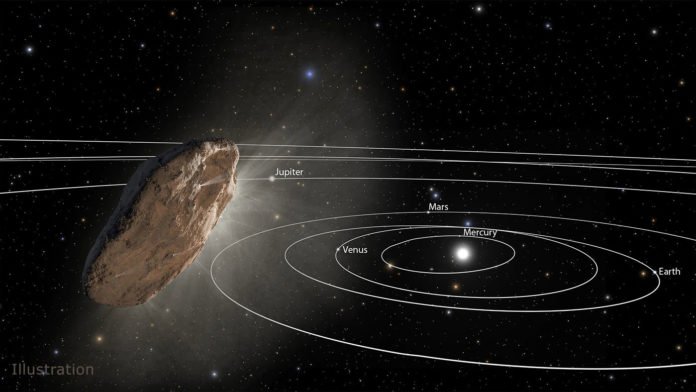Utilizing perceptions from NASA‘s Hubble Space Telescope and ground-based observatories, a universal group of researchers has affirmed ‘Oumuamua’ (goodness MOO-ah-MOO-ah), the primary known interstellar object traveling through our solar system, got an unforeseen boost in speed and shift in trajectory as it passed through the inner solar system last year.
According to scientists, there was something affecting its motion other than the gravitational forces of the Sun and planets.
Analyzing the trajectory of the interstellar visitor, scientists discovered that the speed boost was consistent with the behavior of a comet.
Davide Farnocchia of the Center for Near Earth Object Studies solar system.
Usually, comet exerts a lot of dust and gas when warmed by the Sun. Be that as it may, as per group researcher Olivier Hainaut of the European Southern Observatory, “There were no unmistakable indications of outgassing from ‘Oumuamua, so these powers were not anticipated.
‘Oumuamua’s outgassing may have produced very small dust particles.
Karen Meech, an astronomer at the University of Hawaii’s Institute of Astronomy and co-author of the study, speculated that small dust grains, present on the surface of most comets, eroded during ‘Oumuamua’s long journey through interstellar space.
“The more we study ‘Oumuamua, the more exciting it gets. I’m amazed at how much we have learned from a short, intense observing campaign. I can hardly wait for the next interstellar object!”
Since ‘Oumuamua is the principal interstellar object at any point seen in our close planetary system, scientists alert that it’s hard to make general inferences about this newfound class of heavenly bodies.
However, observations point to the possibility that other star systems regularly eject small comet-like objects, and there should be more of them drifting among the stars. Future ground- and space-based surveys could detect more of these interstellar vagabonds, providing a larger sample for scientists to analyze.
The international team of astronomers used observations from Hubble, the Canada-France-Hawaii Telescope in Hawaii, the Gemini South Telescope, and the European Southern Observatory’s Very Large Telescope in Chile.
Journal Reference
- Micheli, M., Farnocchia, D., Meech, K.J. et al. Non-gravitational acceleration in the trajectory of 1I/2017 U1 (‘Oumuamua). Nature 559, 223–226 (2018). DOI: 10.1038/s41586-018-0254-4
